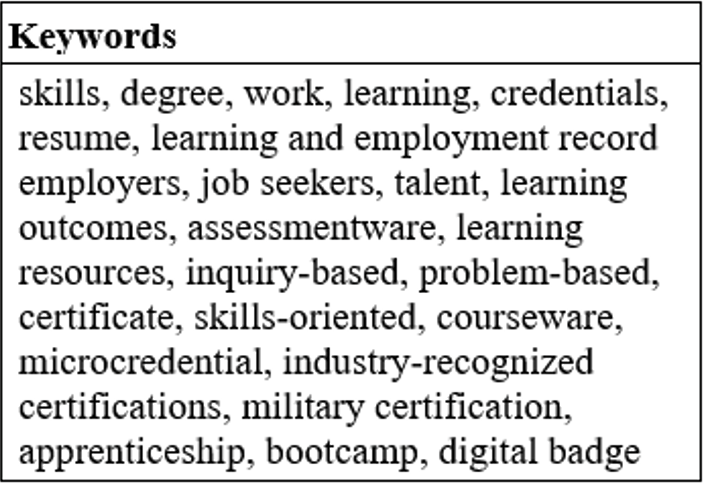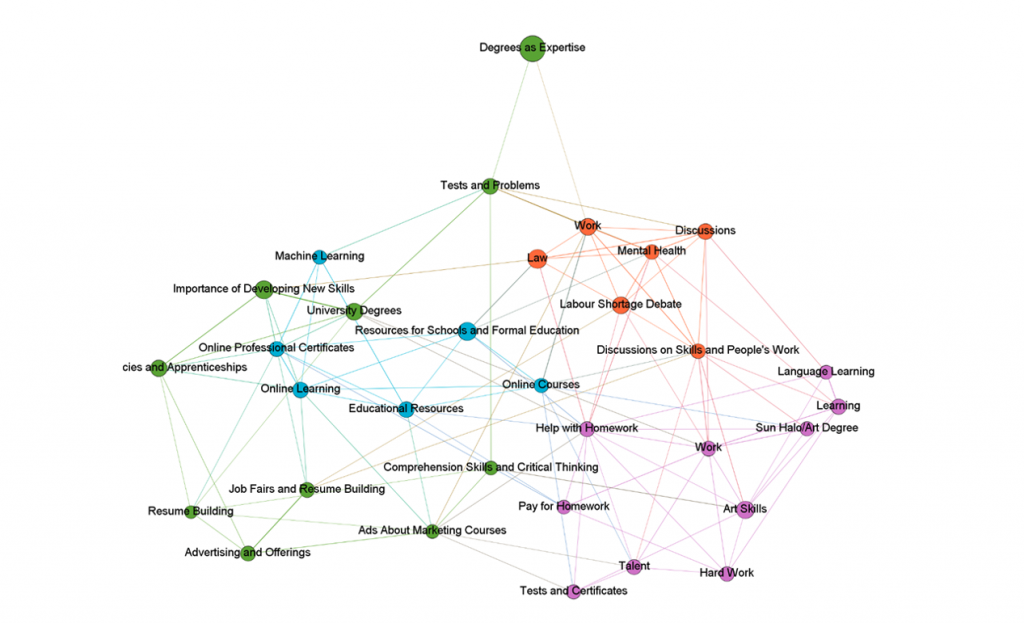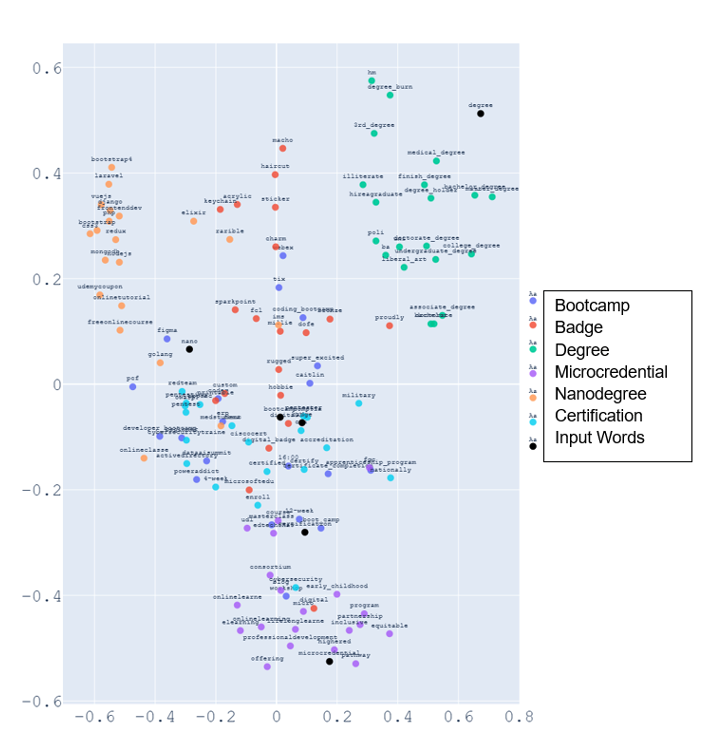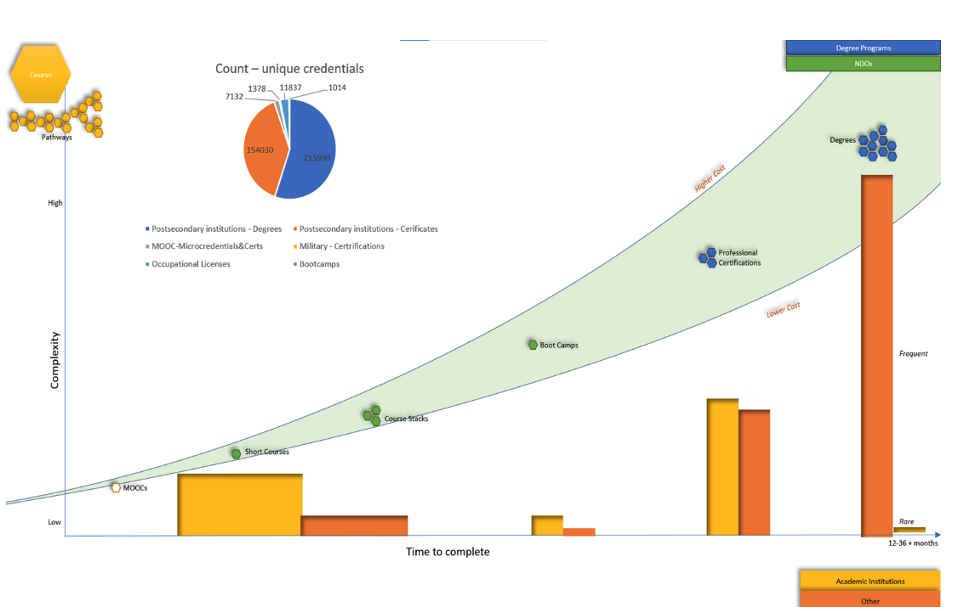Published on
Packaging the Educational Product for the Digital Economy

Marketers have long sought more efficient ways to understand customers’ preferences. With social media use nearly universal today, it is possible to tap into a wealth of data to help understand where the market is heading. Specifically, many academics are seeking to understand how prospective students assign value to various educational offerings.
As educational institutions increasingly focus on microcredentials, we want to look at customer sentiment to gauge if the public sees microcredentials, nanodegrees, boot camps and certifications as viable pathways to career advancement. This is a particularly important question considering the work of organizations like Coursera, Udemy and Udacity, where traditional degree packaging for educational offerings is being challenged.
Leanings From the Twitterverse
With Twitter users as a proxy, we sought to understand the degree to which the public knows the differences between various educational offerings. This is a key question as the answer helps inform educational providers’ choices in positioning and designing their offerings. We used theme analysis, machine learning and network analysis to answer the question.
We analyzed nearly 400,000 tweets including related keywords (Figure 1) using a combination of topic modelling and network analysis approaches. The algorithm determines topics by assigning each word a probability of being mentioned within a model where a group of documents contains a mixture of topics and identifies thematic structures.
Figures 2-4 highlight some findings on how individuals understand various labels commonly attached to educational packages.

Figure 1. Keywords present in the 377,175 tweets considered in the analysis, posted between May 17 and May 25, 2021.

Figure 2. Network graph of the themes identified on Twitter by the users discussing educational offerings and professional advancement. The nodes represent topics; the edges represent the co-occurrences of topics in different documents; the size is established by the importance of the topics. 31.25% of the topics discuss time and efforts put into work and degrees (theme: effort, color: purple), 18.75% discuss various related social topics (theme: Discussions, color: orange), 18.75% of the items discuss the theme of resources (color: blue), and 31.25% focus on the theme of advancement (color: green).

Figure 3. Top 10 similar words to education packaging labels, identified using cosine similarity measure. The similarity is depicted in 2D space in Figure 4.

Figure 4. Two-dimensional representation of the most similar words for educational packaging labels. Similarity is calculated using cosine measures. Each word’s position is the result of the word embeddings and Principal Component Analysis algorithms. Clear clusters emerge around the terms degree, nanodegree and microcredential (most clearly differentiated word groups). Certification, badge and bootcamp show clear overlaps, indicating a lack of disambiguation in the terms used in the discussions of their offerings.
The Value Proposition
Formal offerings such as university-granted degrees and non-formal offerings — including boot camps, nanodegrees or microcredentials—are intensely discussed and seen both as a valid source of professional development and educational advancement. The economic benefits are a strong signal for shifts in both employer and labor market views of the value and validity of non-formal offerings. This finding should not be overlooked by higher education institutions and leaders, as they need to be aware of this trend and adapt to the changing landscape. This is especially true when one considers the price differences between pursuing a degree versus other credentials, such as a microcredential. The study suggests that we need to solidify the emerging labels and taxonomies of educational packaging and socialize offerings. We offer one such taxonomy in Figure 5 that is loosely based on data for credentials awarded in the United States.

Figure 5. A graphical, multidimensional depiction of a possible taxonomy of educational products that considers typical length, amount of effort, duration and popularity. The charts in the figure are based on the data from the CredentialEngine 2019 report: https://credentialengine.org/counting-credentials-2019-report/
If the less expensive education offerings offer similar benefits in terms of employment opportunities, the equation related to one’s return on investment will shift. The economic benefit is important but not the only factor. Based on the adage that time is money, one must also consider the time it takes to complete an educational offering. Learners are seeking alternatives that allow them to demonstrate competency in the skills employers value and readiness for the labor market as quickly as possible.
A key factor is quality. Although lower cost and faster time to completion are attractive, these components carry little value if the quality of learning does not provide merit. Skill relevancy and the quality of the resources are significant factors when it comes to the value equation. Many higher education institutions would make the case that the value they provide is found in the quality and rigor of their degree offerings. However, the analysis showed that Twitter users see both formal and non-formal offerings as valid ways to advance their careers. The discussions of professional advancement that degrees provide overlapped with discussions of professional advancement provided by non-formal educational offerings.
As universities look at alternative ways to package their offerings, we found microcredentials are associated with formal educational organizations. Focusing on developing microcredentials appears to be an attractive option, as using the microcredential nomenclature would support differentiation between formal and non-formal educational providers. Conversely, the title of nanodegree for an educational offering also appears to be linked to formal higher education institutions, but the term nanodegree is more often connected with offerings at organizations like Udacity, where programs are intended to be completed in a shorter time frame.
Industry Implications
The finding that formal and non-formal educational offerings are both perceived as valuable to professional and career development is also significant from an industry perspective. This view creates opportunity for entrants in education. No longer is the imparting and validation of learning limited to degree-granting institutions. Any organization with the ability to create learning resources that impart knowledge can establish themselves as an educator.
It also carries significant implications for accreditors. For example, if an organization’s market forces and brand reputation are all that is needed to gain a foothold in the education space (e.g., Coursera), how should standards be applied to accredited degree-granting organizations? Should degree offerings and non-degree microcredentials be held to the same standard as non-accredited organizations?
Holding institutions of higher education to higher standards puts them at a disadvantage unless the standards lead to improvements. The key is public and employer perception.
Summary
The digital economy has brought transformation to the education industry just as it has many other industries. Change particularly affects historic providers of higher education. It is critical that colleges and universities stay abreast of non-formal offerings and look for opportunities to respond. Additionally, there is an opportunity for differentiation for organizations that solve the issue by creating a marketplace and an opportunity to validate and communicate the skills one has gained. Many are working to meet this need and create ways to validate and exchange skills and competencies. Innovation leads to change, which propagates additional innovation.
Author Perspective: Administrator



